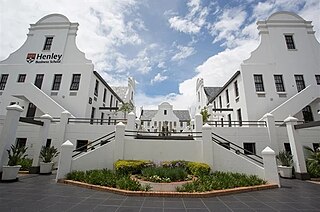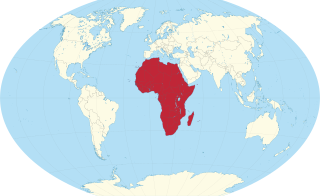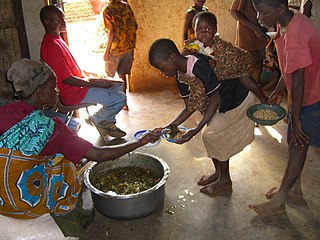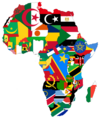Related Research Articles
Distance education, also known as distance learning, is the education of students who may not always be physically present at school, or where the learner and the teacher are separated in both time and distance. Traditionally, this usually involved correspondence courses wherein the student corresponded with the school via mail. Distance education is a technology-mediated modality and has evolved with the evolution of technologies such as video conferencing, TV, and the Internet. Today, it usually involves online education and the learning is usually mediated by some form of technology. A distance learning program can either be completely a remote learning, or a combination of both online learning and traditional offline classroom instruction. Other modalities include distance learning with complementary virtual environment or teaching in virtual environment (e-learning).

Sub-Saharan Africa, Subsahara, or Non-Mediterranean Africa is the area and regions of the continent of Africa that lie south of the Sahara. These include Central Africa, East Africa, Southern Africa, and West Africa. Geopolitically, in addition to the African countries and territories that are situated fully in that specified region, the term may also include polities that only have part of their territory located in that region, per the definition of the United Nations (UN). This is considered a non-standardized geographical region with the number of countries included varying from 46 to 48 depending on the organization describing the region. The African Union (AU) uses a different regional breakdown, recognizing all 55 member states on the continent—grouping them into five distinct and standard regions.

Universal access to education is the ability of all people to have equal opportunity in education, regardless of their social class, race, gender, sexuality, ethnic background or physical and mental disabilities. The term is used both in college admission for the middle and lower classes, and in assistive technology for the disabled. Some critics feel that this practice in higher education, as opposed to a strict meritocracy, causes lower academic standards. In order to facilitate the access of education to all, countries have right to education.

Open educational resources (OER) are teaching, learning, and research materials intentionally created and licensed to be free for the end user to own, share, and in most cases, modify. The term "OER" describes publicly accessible materials and resources for any user to use, re-mix, improve, and redistribute under some licenses. These are designed to reduce accessibility barriers by implementing best practices in teaching and to be adapted for local unique contexts.
The history of education in Africa can be divided into pre- and post-colonial periods. Since the introduction of formal education by European colonists to Africa, African education, particularly in West and Central Africa, has been characterised by both traditional African teachings and European-style schooling systems.

Henley Business School, Africa, in the Paulshof suburb of Johannesburg, is a branch of the British-based Henley Business School, part of the University of Reading and one of the oldest business schools in Europe with operations in 17 countries across the globe. The African institution, which is locally accredited and has offered the MBA in South Africa since 1992, shares international accreditation with its parent school and is also locally accredited in South Africa. The South African campus has offered the MBA in South Africa since 1992. In 2002, the South African location became a fully owned subsidiary of its British parent. As the operation in South Africa is the only Henley Business School on the African continent, it has students living in neighbouring countries studying and being supported through this office. Henley Africa has two South African campuses, one in the Paulshof suburb of Johannesburg, and the other in Woodstock, Cape Town, and services students living in South Africa and neighbouring countries.
Education in Kenya refers to the education system in Kenya. It is considered a basic right that should be offered to every individual. Education in Kenya predates to as early as the 18th century among the Swahili people. The earliest school was established by missionaries in Rabai. During colonial rule, a limited number of Kenyans were able to access higher education opportunities abroad.

Education in Rwanda has undergone considerable changes throughout Rwanda's recent history, and has faced major disruptions due to periods of conflict. Education was divided by gender whereby women and men had a different education relevant to their responsibilities in day-to-day life. Women were mostly taught housekeeping while men were mainly taught how to hunt, raise animals, and fish. This is because Rwanda was a community-based society where every member had a specific contribution to the overall development of the community. Older family members like grandparents usually took on the role of educators.
The Senegalese education system is based on its French equivalent. The state is responsible for the creation of an educational system that enables every citizen access to education. Articles 21 and 22 of the Constitution adopted in January 2001 guarantee access to education for all children. However, due to limited resources and low demand for secular education in areas where Islamic education is more prevalent, the law is not fully enforced.

The population of Africa has grown rapidly over the past century and consequently shows a large youth bulge, further reinforced by a low life expectancy of below 50 years in some African countries. Total population as of 2024 is about 1.5 billion, with a growth rate of about 100 million every three years. The total fertility rate for Africa is 4.7 as of 2018, the highest in the world according to the World Bank. The most populous African country is Nigeria with over 206 million inhabitants as of 2020 and a growth rate of 2.6% p.a.

Female education is a catch-all term for a complex set of issues and debates surrounding education for girls and women. It is frequently called girls' education or women's education. It includes areas of gender equality and access to education. The education of women and girls is important for the alleviation of poverty. Broader related topics include single-sex education and religious education for women, in which education is divided along gender lines.

There have been major strides with Education in Equatorial Guinea over the past ten years, although there is still room for improvement. Among sub-Saharan African countries, Equatorial Guinea has one of the highest literacy rates. According to The World Factbook - Central Intelligence Agency as of 2015, 95.3% of the population age 15 and over can read and write in Equatorial Guinea were respectively literate. Education in Equatorial Guinea is overseen by the Ministry of Education and Science (MEC). Split into four levels, preschool, primary, secondary, and higher education, the Equatorial Guinea's educational system only deems preschool and primary school mandatory. Education in Equatorial Guinea is free and compulsory until the age of 14. Although it has a high GNI per capita, which, as of 2018, was 18,170 international dollars, its educational outcomes fall behind those of the rest of West and Central Africa. In 1993, the gross primary enrollment rate was 149.7 percent, and the net primary enrollment rate was 83.4 percent. Late entry into the school system and high dropout rates are common, and girls are more likely than boys to drop out of school. As of 2015, the net enrollment rates for each education level are as follows: 42 percent for preschool, between 60 percent and 86 percent for primary school, and 43.6 percent for secondary school. UNESCO has cited several issues with the current educational system, including poor nutrition, low quality of teachers, and lack of adequate facilities.

During the period of 1965 – 2021, an estimated 440,000 people per year emigrated from Africa; a total number of 17 million migrants within Africa was estimated for 2005. The figure of 0.44 million African emigrants per year pales in comparison to the annual population growth of about 2.6%, indicating that only about 2% of Africa's population growth is compensated for by emigration.

The World Bank defines school feeding programs as "targeted social safety nets that provide both educational and health benefits to the most vulnerable children, thereby increasing enrollment rates, reducing absenteeism, and improving food security at the household level." In addition to enhancing access to food, these programs positively affect nutritional status, gender equity, and educational outcomes, contributing to the overall advancement of country and human development.

The African Forum for Agricultural Advisory Services (AFAAS), is an African organization for strengthening Agricultural Extension and Advisory Services (AEAS) in Africa. It operates within the framework of the Comprehensive Africa Agriculture Development Programme (CAADP), a venture of the African Union in the New Partnership for Africa's Development (NEPAD). AFAAS is an autonomous subsidiary of the Forum for Agricultural Research in Africa (FARA).
The African Storybook (ASb) is a multilingual literacy initiative that works with educators and children to publish openly licensed picture storybooks for early reading in the languages of Africa. An initiative of Saide, the ASb has an interactive website that enables users to read, create, download, translate, and adapt storybooks. The initiative addresses the dire shortage of children's storybooks in African languages, crucial for children's literacy development. As of March 2023, the website had 3 800 original titles, 7 266 translations and 236 languages represented.

Victor Mbarika is an American professor from Cameroon. He is currently the Stallings International Distinguished Scholar and MIS professor at East Carolina University within the University of North Carolina System, in Greenville, North Carolina, United States. He is the President, Board of Trustees of the ICT University.
Educational technology in sub-Saharan Africa refers to the promotion, development and use of information and communication technologies (ICT), m-learning, media, and other technological tools to improve aspects of education in sub-Saharan Africa. Since the 1960s, various information and communication technologies have aroused strong interest in sub-Saharan Africa as a way of increasing access to education, and enhancing its quality and fairness.
Youth in Africa constituted 19% of the global youth population in 2015, numbering 226 million. The United Nations defines youth as people aged 15 to 24 years. By 2030, it is predicted that the number of youths in Africa will have increased by 42%. Africa's population as a whole is very young, with 60% of the entire continent aged below 25, making it the youngest continent in the world, in relation to its population makeup. All of the world's top 10 youngest countries by median age are in Africa, with Niger in first place with a median age of 15.1 years. There is contention among critics and analysts over what this demographic dividend could mean for African nations; some believe that, with effective governance, the economy could significantly benefit and develop, whilst others have argued that a large, poorly-managed youth population may lead to greater instability and civil conflict.

Sustainable Development Goal 4 is about quality education and is among the 17 Sustainable Development Goals established by the United Nations in September 2015. The full title of SDG 4 is "Ensure inclusive and equitable quality education and promote lifelong learning opportunities for all".
References
- ↑ Kyama, Reuben. "African Virtual University makes an actual impact". universityworldnews.com. Retrieved 14 February 2014.
- ↑ "AfDB and African Virtual University discuss benefits of e-learning". afdb.org. Retrieved 14 February 2014.
- ↑ Light, David A. (1999-09-01). "Pioneering Distance Education in Africa". Harvard Business Review. ISSN 0017-8012 . Retrieved 2022-12-21.
- 1 2 Simmons et al. 2011, p. 78.
- ↑ Simmons et al. 2011, p. 79.
- 1 2 3 4 Simmons et al. 2011, pp. 82–83.
- ↑ "African Virtual University: Transforming Africa into a Global Knowledge Hub". African Development Bank (in French). 2019-03-14. Retrieved 2022-12-21.
- ↑ Anderson, Mark (2015-05-20). "Out of Africa: e-learning makes further education a reality for tens of thousands" . Retrieved 2022-12-21.
- 1 2 3 M. Nafukho, Fredrick; Helen Muyia, Machuma (2013-08-23). "The World Bank ' s Africa Virtual University Project: a revisit". European Journal of Training and Development. 37 (7): 646–661. doi:10.1108/ejtd-02-2013-0020. ISSN 2046-9012.
- 1 2 3 Munene, Ishmael I. (January 2007). "Experimenting in distance education: The African virtual university (AVU) and the paradox of the World Bank in Kenya—A rejoinder". International Journal of Educational Development. 27 (1): 77–85. doi:10.1016/j.ijedudev.2006.05.002. ISSN 0738-0593.
